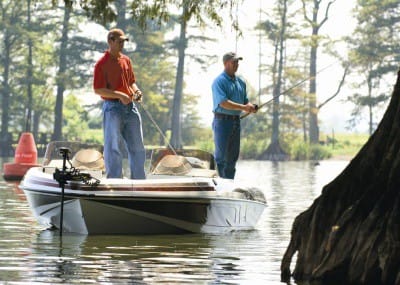 If a bass could build its ideal habitat, the specs would be something like this: shallow water, in or near heavy cover with quick access to deep water nearby. While the nearby deep-water access is good news for anglers (you need some place to float your boat), pulling bass out of water in or near heavy cover can pose some access problems.
If a bass could build its ideal habitat, the specs would be something like this: shallow water, in or near heavy cover with quick access to deep water nearby. While the nearby deep-water access is good news for anglers (you need some place to float your boat), pulling bass out of water in or near heavy cover can pose some access problems.
Safe and secure in its ideal surroundings, the bass has an ideal ambush point should it decide to feed on baitfish or crawfish. This bass isn’t going to have a very big strike zone, so don’t expect it to come charging out from the cover to devour any fast-moving bait that just happens to be in the area. You are going to have to put this bait right where the bass lives. You may have to get the bait in through an opening no bigger than a coffee can or under low-hanging trees—all the while making sure not to spook the fish by causing a big splash with every cast. You are going to have to pitch.
Pitching is the same technique that anglers have employed for centuries when they tied lengths of line to the end of cane poles. It allowed them to guide the bait to a desired location. They did this without the high-tech rods and reels we now have at our disposal. It worked then and it works even better today. Whether it’s getting your bait in a small opening near heavy cover, under low-hanging limbs or around boat docks, being a proficient pitcher can make your days on the water much more successful.
Ideal for using in off-color or muddy water (as most lakes tend to be this time of year as they are stirred up by the wind and hard rain), pitching is best for targets between 10 and 30 feet away and provides a very quiet lure entry. Standard equipment for me is 25-pound test Berkley Big Game line and a 7-foot-6-inch Fenwick Techna AV Flippin’Stik (at least 7 feet in length is a must for a casting rod). It’s a heavy rod with plenty of backbone to wrestle big fish out of cover with a moderate action for easier strike detection.
A must for anglers who use jigs, nearly any single-hook bait can be pitched, but my all-time favorite bait is a Berkley 4-inch Power Flippin’ Tube. With this Texas-rigged bait on the line, I face the target, depress the line release trigger and let out enough line so that the bait is even with the first guide. With the bait in my off-hand and about waist level, I lower the rod tip toward the water and put some tension on the line. In one smooth, quick motion, I swing the rod tip toward the target and upward, letting go of the bait in my free hand. This is all controlled with the wrist – arm movement is not a factor. As the bait moves beneath the rod tip, release the line and continue raising the rod tip and control the spool with your thumb. The bait should fly just above the water’s surface and should land in its desired location through a combination of line tension and rod movement. Stopping the bait just before it enters the water almost always ensures a smooth, splash-free entry.
Pitching has been a go-to technique for anglers for years. But it takes practice. Set up some drills in the backyard or anywhere else you have room. Even if you can’t be on the water, you can still be sharpening your skills to make the next trip a success. Learn to make accurate, quiet casts and pitching will likely become one of your favorite ways to target big fish.
Larry Nixon is a former Bassmaster Classic winner with more than $2 million in career earnings. Nixon lives in Bee Branch, Ark.



